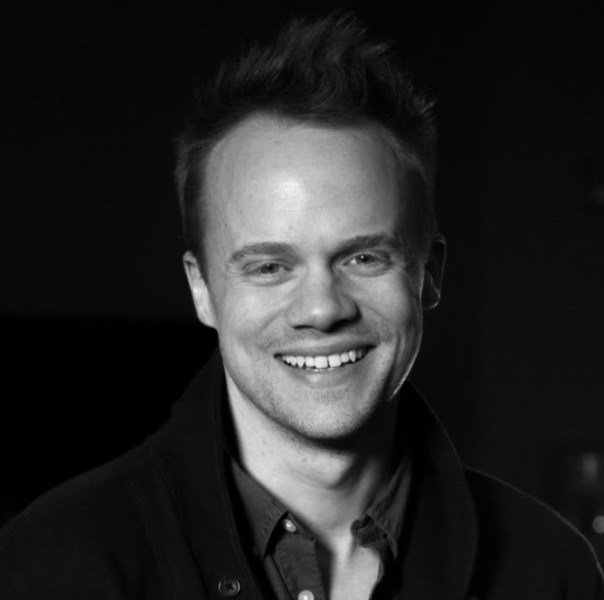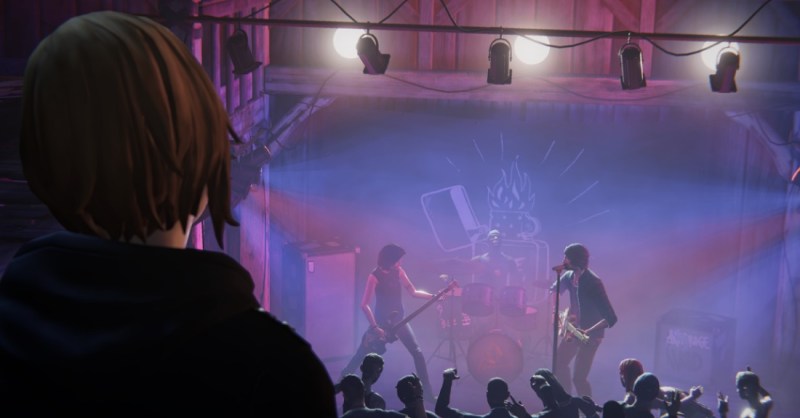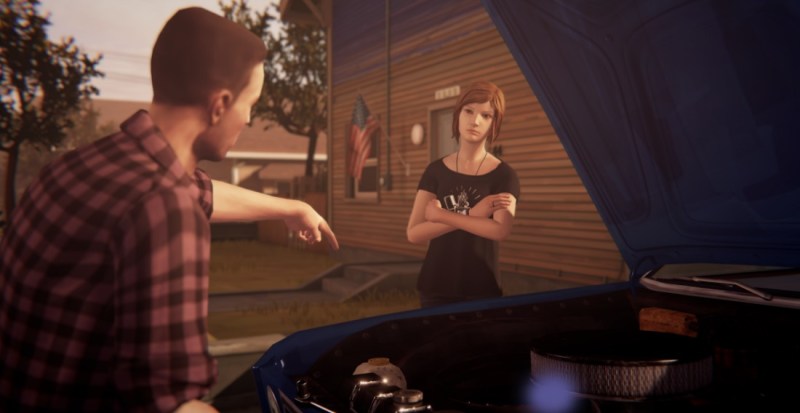Life Is Strange sold more than 3 million copies because it had such appealing portraits of trouble teens. And developer Deck Nine is taking the teen angst narrative and running with it in the upcoming prequel Life Is Strange: Before the Storm.
The first episode of the game debuts on PlayStation 4, Xbox One, and Windows PC on August 31. And I got yet another peek at the episode and the relationships that are unfolding within it. I also interviewed lead writer Zak Garriss at Deck Nine.
The original game focused on the perspective of character Maxine “Max” Caulfield, a high school student in the town of Arcadia Bay, Oregon, during October 2013. She realizes she can rewind time at any moment, helping her perfect her choices and prevent big problems by enacting little changes via the “butterfly effect.” In the game, the player faces a choice of saving a large number of people or helping a friend.
In the prequel, Max’s best friend, Chloe Price, is 16 years old as the story takes place about three years before the events of the original game. Chloe meets another friend, Rachel Amber, and that starts a new adventure of choice and consequences. This week, publisher Square Enix showed a new video of how Chloe is getting along with a potential new stepfather, David.
Garriss said the story will branch based on the choices you make. And one of those choices is whether to nudge Chloe and Rachel into a romantic relationship. I talked about that and the potential consequences with Garriss.
“The most successful moments of the first game weren’t about the science fiction,” Garriss said. “They were about the humanity, the personalities, the kind of characters they constructed. That is what we tried to focus Before the Storm on. We are cultivating those deeper connections and trying to make flawed characters. We focus on that, and that is more than enough for a rich game story.”
Here’s an edited transcript of our interview.

Above: Zak Garriss, writer for Life Is Strange: Before the Storm.
GamesBeat: I played the game last week in San Francisco. I wonder at this point how much of the game I saw, though. I played the opening section you showed at E3, and then I saw the video of what happened the next day with her stepdad.
Zak Garriss: That’s some of my favorite content, but it’s a pretty small portion of the first episode. I don’t want to spoil too much. What we’re seeing in those scenes is a day in the life of Chloe Price at the time our game starts. It’s her trying to go to a concert she probably shouldn’t be at, getting in trouble with her mom, having to go to school, having to deal with the fact that her mom is moving on. Pretty quickly, business as usual for Chloe will get wildly interrupted when she reconnects with Rachel, after what happened at the concert that night. It’s laying the foundation for that connection, and for how the rest of her day is going to end very differently from the way it starts.
GamesBeat: It’s a prequel, which is interesting, because we know that in some sense where this eventually winds up. Can you talk about writing this story in the context of knowing where the character goes?
Garriss: The first game starts where Max is at Blackwell and we’re learning about Rachel Amber, this girl who disappeared. Everyone has something to say about Rachel, and that’s a big part of the story overall. Before the Storm is not the story of Rachel’s disappearance. We’ve set the narrative three years before the events of the first game. We’re focused on a very particular window in Chloe’s life. It’s two years since her dad died, since Max moved away. Chloe is 16. She’s burning bridges at home and at school. She’s alienated. What’s it like for her in that place? And she meets someone who completely upsets everything.
Even in the first game, even with Max, when Chloe’s talking about Rachel, we can tell that she feels very deeply about her, but she doesn’t speak to specifics at all as far as what that relationship is like. We deliberately put our story in that meeting moment and what it’s like for them when they kind of meteorically combine, because it creates a window for the player to have a choice in how things unfold. Even the most die-hard fans of season one won’t know the ending of this story. It’ll have surprises and mysteries that the first game doesn’t spoil.
GamesBeat: It looks like you built a space where you have quite a bit of freedom, then.
Garriss: We hope that freedom extends to players. They’ll then have the freedom to make really difficult choices, to navigate the story, and deal with consequences to their choices. That’s core to the franchise.

Above: Chloe watches the Firewalk concert in Life Is Strange: Before the Storm.
GamesBeat: I take it some of the choices are more trivial as far as how the game unfolds, and then some of them are bigger.
Garriss: Well, you can say that some are trivial. They’re seemingly trivial. Sometimes you make certain choices and the consequences may not be a surprise. But there are also many seemingly minor choices that will have consequences that ripple through the entire game. Even in the demo, in the piece you saw at the Mill about whether you steal money or whether you buy weed from Frank, that has so many repercussions. That’s a relatively innocuous thing for a 16-year-old to do. In the context of the larger story that doesn’t directly or obviously pertain. But the story will hold and respond to–even the smallest of decisions you make could potentially really surprise you.
GamesBeat: Is there a certain vibe the player should be getting about the relationship between the two characters? It seems romantic, but I wasn’t sure if you were deliberately going for that.
Garriss: We’re accepting of the canon idea that—regardless of the nature of the relationship between the girls, it was incredibly significant for Chloe. Rachel going missing right before the events of the first game, that destroys Chloe. It challenges her and puts her in a really dark place where she needs Max. We’re working from that foundation. Whatever their relationship was, romantic or not, it was huge for Chloe. It was meaningful. We’re letting the player navigate the uncertainty of what that relationship is and make choices about it that could go to any number of places.
GamesBeat: Do you leave the possibility of a romantic relationship open, or is that simply not part of the story?
Garriss: It’s definitely a part of the story. If players choose to pursue a romantic relationship with Rachel, if their choices result in that, it’s very much a part of the story. Even allowing for that possibility, which our story does, does a lot of work to represent that community in a way that I think it hasn’t been historically represented in games. The first Life is Strange was very intentional, very careful, and we think very successful about doing that.
In reality there are more than just two ways the way the relationship can move forward. If it’s romantic or not, that’s one way to slice it, to make it into a binary. But one thing we explore that relationships aren’t static. They’re not decided in a single moment. It’s an ongoing conversation. Your own feelings will change, especially when you’re a teenager, and we’ll have choices and context that reflect that. The other person in a relationship, friendly or more so, changes and evolves too. You learn things about them that might change your association with them.
By no means are we attempting to simply simulate one kind of relationship or another. We’re telling a complex story about a lot of real-world issues, and we’re having the nature of the principal relationship between these two girls add complexity and live in a gray space. We’re letting the player make a lot of choices about it that will inform how the girls interact with each other, how they relate, and how they communicate. Even where Chloe gets her vocabulary from, certain words—you may be surprised about where that comes from.
GamesBeat: Does the game story remain the same regardless of what path you take in their relationship?
Garriss: I don’t think I’d say that. There are ways in which different parts of the story would care about something like that, and there are ways in which some parts would—what we try to do is tell a relatable story that feels organic, that feels authentic, and that deals with real-world issues. There are spaces where the nature of Chloe’s relationship with Rachel matters and you’ll see the story reflect that, and maybe there are spaces where you won’t see that.

Above: Chloe isn’t a fan of her potential stepfather David.
GamesBeat: Can you tell us about her potential stepfather, that relationship? It seems like Chloe is very actively distancing herself from him.
Garriss: She’s pretty resistant to David, yeah. There are ways in which it’s because she just doesn’t like him, and I think there are ways in which it reflects the fact that Chloe isn’t ready to move on from her father’s death. Her mother is trying to move on, and Chloe has to choose whether she’s willing to accept that. We’re pretty excited about that path, exploring what it might be like her at 16, and how alienating it can be for her that her mom is trying to be happy, while Chloe isn’t sure she’s ready to be that way yet.
GamesBeat: I got a feeling that David maybe isn’t very likable, even from a neutral perspective.
Garriss: We’ll see. As Before the Storm progresses, based on Chloe’s choices, she might get a lot more insight into who David is and where he’s coming from. That likability, or the larger question of how welcome he is in the home—some things might make it more challenging for her to answer that question, and more challenging for the player.
GamesBeat: Would you consider him a big part of the story?
Garriss: He’s definitely a part of the story. The first game was very successful at cultivating all kinds of narrative threads, and all kinds of personalities for Max to interact with. We’re striving to do the same thing. We have these different spheres of Chloe’s life: her home life, what’s going on at Blackwell, what’s going on in the community at Large. The mystery she’s uncovering, the journey she’s going on with Rachel will cross all of those boundaries and move from one space to another. We’ll see all sorts of characters and relationships emerge from that. David is one of them, for sure.
GamesBeat: How much of the overall story should we expect to see in episode one?
Garriss: In a lot of ways, episode one is a chance to see Arcadia Bay at this time, to see a lot of these narrative threads begin, and raise a lot of questions and challenges that episodes two and three will explore in more detail.
GamesBeat: So we see a lot of new stories begin.
Garriss: It’s definitely intended to be part of a three-episode arc. There will be threads that begin and to some extent are resolved within episode one, but for the most part it’s just part of a much larger story that happens over all three episodes.

Above: Chloe and her mother aren’t on great terms in Life Is Strange: Before the Storm.
GamesBeat: As a developer, is it easier for you having learned so much collectively from the experience of the first game?
Garriss: Something that Dontnod did in the first game that we took a lot of lessons from—they had a courage in focusing on small stories, personal stories. The game has a quantum tornado that threatens to destroy the town, which is very big, and Max can time-travel, which is big and fantastical, but the heart of the game–the most successful moments of the game weren’t about the science fiction aspect. They were about the humanity and the personalities of the characters they constructed.
That’s where we’ve chosen to focus in Before the Storm. It’s about cultivating those deeper connections, trying to make flawed characters, and focus on that. That’s more than enough for a rich game story. That’s going to be a really unique and interesting experience. The trail that Dontnod blazed in that way is something that we’ve followed.
GamesBeat: Is there anything else that you think is worth pointing out in the gameplay that’s been revealed so far?
Garriss: I guess I’d say that we’re just really excited to put the game in front of fans now, to hear their responses and share this next chapter with them. We think that living in Arcadia Bay, returning to it through Chloe’s eyes, being in her shoes, having to live in her interior world – which we didn’t get in the first game – will make for a very different gameplay experience and a very different story experience compared to playing as Max. But we think that will happen in way that will still resonate. We certainly hope so.

